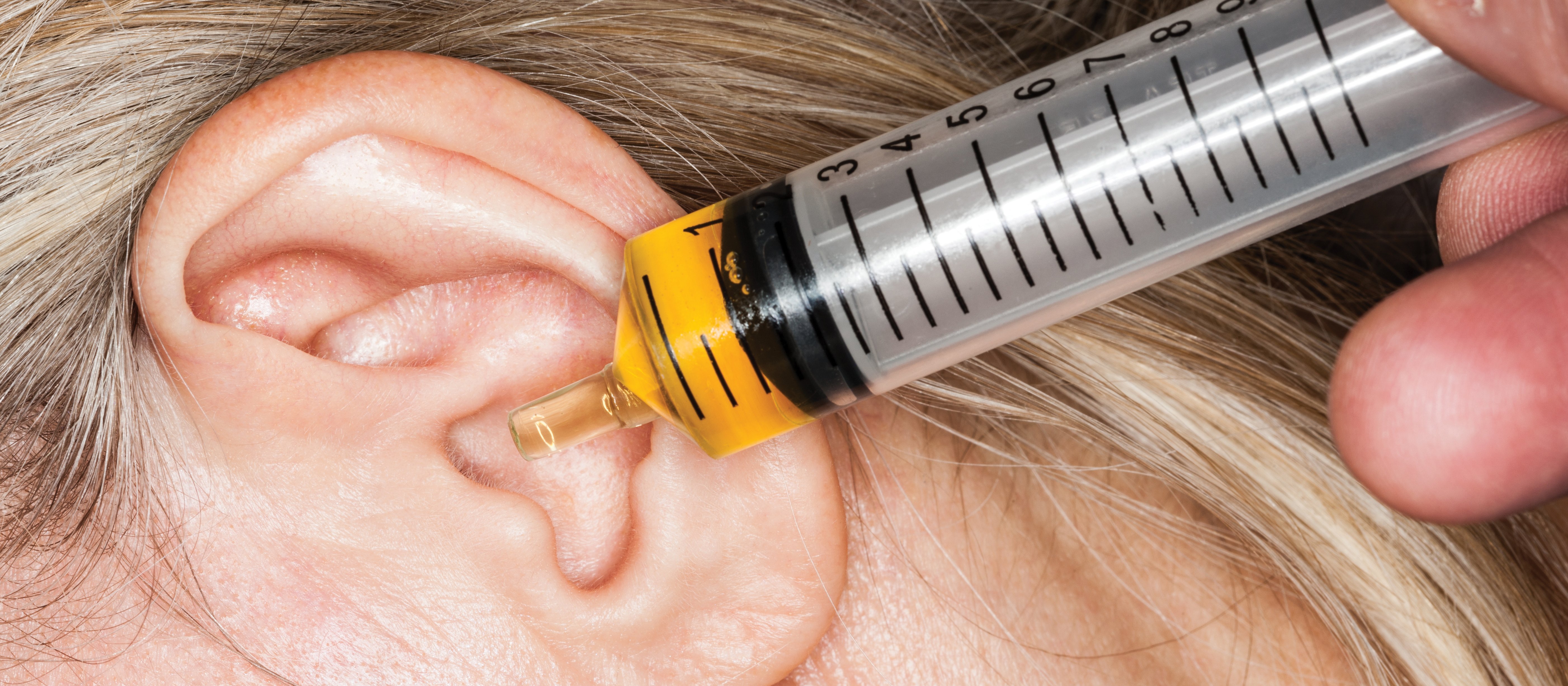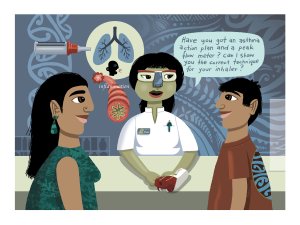Academic pharmacist Nataly Martini discusses the medical management of asthma in adults and adolescents, which has evolved to prioritise early anti-inflammatory treatment. She also explains how to improve patient outcomes by proactively identifying poor asthma control and supporting equitable access to education and treatment
What to do when earwax doesn’t take care of itself
What to do when earwax doesn’t take care of itself

DAVE ASKS YOU for something for his ears. He says that when he coughs or sneezes, he immediately gets a sore ear, and often it feels like he has water in them. It’s even worse when he chews because they start ringing or making a shuffling or other weird noise. Sometimes, he can hear noises inside his ears when he sits still. He says he finds it difficult to hear people talking, particularly when there is a lot of background noise.
Ideally, the best thing to do with earwax is nothing
Earwax (also called cerumen) is a mixture of sebum secreted from tiny sebaceous glands inside your ear, cholesterol and other long-chain fatty acids. It also contains dead skin cells (keratin) and tiny hairs, and it is slightly acidic. Its role is to coat and lubricate the ears and prevent them from drying out, and to trap dust and pathogens, protecting the delicate skin that lines the ear canal from infection. Historically, it was used by seamstresses to keep the ends of threads from fraying and as a solution for chapped lips.1–3
Earwax is designed to take care of itself, and ears have been described as one of nature’s great self-cleaning devices. The skin inside your ear is different from the skin on your body, which is always growing and moving up from the deepest layer of the skin to the surface, where it is removed by friction. Because there is no friction in the ear canal, the skin replaces itself through a process called migration, which involves a continual movement of skin cells from the centre of the eardrum and out along the ear canal at a rate of about 3.3cm per year. In the ear canal, the skin sheds off and gets mixed in with earwax.2–4
Ideally, the best thing to do with earwax is nothing, because of this migration and self-shedding. But people have a habit of putting objects, such as cotton buds, pens or hair clips, into their ears to scratch or clean them, which disrupts this natural process. Anything that is put in the ear tends to push the wax in further, and sharper objects can also abrade the ear canal, causing bleeding or skin damage, which can lead to infection. There is also a risk of puncturing the ear drum.1–3,5
Hearing aid and earplug users tend to have issues with earwax build-up as these devices push wax back into the ear canal. In older adults, sebaceous glands often produce increasingly harder earwax, and some people are just born with narrow ear canals, which puts them at higher risk.1–3,5
The colour of earwax varies depending on which variant of the ABCC11 gene people have. Two main types of earwax have been identified: wet and dry. Wet earwax correlates with the dominant form of the gene and is typically yellow, amber-orange or brown, sticky, and more common among people of European and African descent. Dry earwax is usually white to grey and flaky. These people have the recessive form of the gene, which is more common among people of east Asian descent.1,2
Earwax consistency can range from nearly liquid to rock hard. The harder it is, the more likely it is to build up and become impacted. Symptoms of earwax build-up may include difficulty hearing; a feeling of fullness or water in the ear; pain; itchiness; or hearing sounds, such as ringing, buzzing or shuffling from inside the ear. Some people may report a discharge from the ear, feel dizzy or complain of vertigo, or be prone to motion sickness.2,3,5
To maintain healthy earwax and skin migration in the long term, the best thing to do is to put a few drops of olive oil into each ear canal once a week
When talking with somebody about earwax, remind them first that they should not put cotton buds or anything else into their ear. To maintain healthy earwax and skin migration in the long term, the best thing to do is to put a few drops of olive oil into each ear canal once a week.2,3
To solve an immediate problem of hard earwax or earwax impaction that is causing symptoms, earwax softening agents should be tried initially before referring the customer to their doctor or an audiologist. If there is an excessive amount of pain or hearing loss, then consult with a pharmacist (see the Healthcare Handbook 2022–2023 chapter “Ear Conditions” for more information about when to refer).6
Earwax softening agents available in New Zealand may contain:6–9
- apricot kernel oil to lubricate and penetrate earwax
- arachis oil (peanut oil) to soften the wax by dissolution (oil dissolves oil)
- carbamide peroxide, a hydrogen peroxide-urea compound that breaks up and disperses earwax
- chlorobutanol, an antibacterial agent that also has earwax softening properties
- docusate sodium, which has an emulsifying and lubricating action and softens the earwax
- eucalyptus essential oil to lubricate and penetrate earwax.
Olive oil, almond oil and mineral oils may also be used to soften, penetrate and lubricate earwax, allowing easier removal.
When selling earwax softening drops, instruct customers to do the following:
- place the bottle in some warm water for 10 minutes
- lie down with one ear facing upwards
- ask someone to place five drops into the ear (or they can do it themselves, but they must be careful not to touch the dropper to their ear)
- gently cover the ear canal with a small piece of cotton wool smeared with ear drops or petroleum jelly, but warn not to push this too far into the ear canal – it should sit at the entrance to stop the drops from falling out
- wait for 10 minutes, then repeat this with the other ear
- try to leave the cotton wool in place for at least one hour, or overnight if possible.
This whole process should be repeated twice a day for a maximum of three consecutive days; any longer may cause hypersensitivity and irritation. As the drops enter the ear, people may experience a harmless tingling sensation. If strong pain is felt, people should stop using the ear drops immediately and contact their doctor. Often, the loosened wax will discharge on its own, but if there are any signs of impaction, an audiologist or ear nurse will be able to remove any remaining wax using microsuction.6–8
Ear candling uses hollow, cone-shaped candles that, when lit at the other end, are meant to create a suction effect to draw earwax out of the ear canal.
They are extremely unsafe, and reported injuries include burns to the face, ear canal, hair and clothing. They are also ineffective, with the temperatures produced by the candles generally insufficient to soften earwax, and the suction created too weak to suck it out. Any residue left inside the ear candle is just burnt paraffin and fabric – not the purported debris drawn out. The US Food and Drug Administration has warned against their use since 2010 and can seize ear-candling products and fine importers of ear candles. Pharmacies in New Zealand should not stock these and should discourage their use.2,10–12
YOU ASK DAVE if he has had his ears checked by his doctor or an audiologist lately, and he says no. He admits to cleaning them once a week with a cotton bud, but says he only manages to retrieve a small brown blob of wax each time. You say that he may have earwax impaction. You explain the reasons not to use earbuds and recommend he go to an audiologist for a definite diagnosis. You also suggest that he use some earwax softening drops for three days before he goes, to liquify any hard wax and make it easier to be removed. After confirming that he is not allergic to peanuts or soy and has no other contraindications, you sell him some ear drops that contain a combination of arachis oil (peanut oil) and chlorobutanol and instruct him on how to use them. If his symptoms persist, he should make an appointment with his doctor or audiologist for a thorough check.
This case study is hypothetical and does not represent a living, identifiable person
Carmen Pope (née Fookes) is a clinical pharmacist and Healthcare Handbook technical editor
This article forms part of the Healthcare Handbook Education Path. Once you have read this article on earwax, read the corresponding chapter “Ear Conditions” on pages 64–65 of the Healthcare Handbook 2022–2023, then write down your answers to the following questions.
QUESTIONS
1. What is NOT a component of earwax?
a. Sebum
b. Skin cells
c. Water
2. The skin in the ear canal sheds by friction. True or False?
a. True
b. False
3. What is the colour of dry-type earwax?
a. Amber orange
b. Dark brown
c. White to grey
4. Cotton buds are a good device for cleaning out the ear. True or False?
a. True
b. False
5. Which component of earwax softening drops has antibacterial properties?
a. Carbamide peroxide
b. Chlorobutanol
c. Docusate sodium
6. How does arachis oil work in earwax softening products?
a. Allows water to penetrate the earwax
b. Breaks up and disperses the earwax
c. Lubricates and penetrates the earwax
7. Earwax softening agents should be used for a maximum of how long?
a. Three days at a time
b. Five days at a time
c. Seven days at a time
Write down your answers to these questions. Then, to check your answers and record your score, click here
1. Cleveland Clinic. Earwax.
2. Morrison J. Make Peace with Earwax. Hearing Health Foundation, 12 July 2022.
3. Cleveland Clinic. Earwax Blockage.
4. Ears and Hearing UK. The Outer Ear.
5. Cedars Sinai. Impacted Earwax.
6. Fookes C (Tech Ed). Ear Conditions. Healthcare Handbook 2022–2023. Auckland, NZ: The Health Media Ltd; 2022.
7. New Zealand Formulary. 12.1.3 Removal of ear wax. NZF v131; 1 May 2023. nzf.org.nz/nzf_6104
8. Aaron K, Cooper TE, Warner L, Burton MJ. Ear drops for the removal of ear wax. Cochrane Database Syst Rev 2018;7(7):CD012171.
9. Earclear. FAQs.
10. Pinnacle ENT Associates LLC. The Dangers of Ear Candling. 10 March 2020.
11. Connect Hearing. The Dangers of Ear Candling. 27 January 2021.
12. US Food and Drug Administration. Import Alert 77-01. 18 October 2022.





